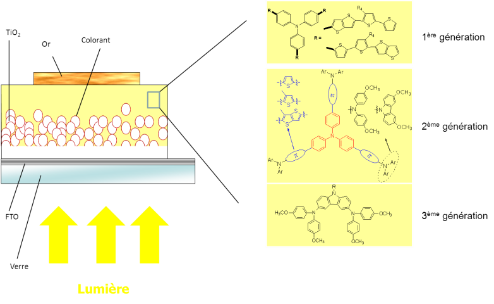You are here :
- Unité de recherche
- CY LPPI
- Home page
- Research Subjetcts
- Photovoltaic
Photovoltaic
People In charge: Fabrice Goubard
The concept of rips has also been applied to the realization of devices for organic photovoltaic. Indeed, the association in this architecture of 2 materials that have respectively n doping and p doping properties induces a micro phase segregation that favors the dissociation of excitons and a more efficient charge transport to the electrodes. Charge transfer can be optimized due to the large interface that is established if the materials are properly interpenetrated. In addition to diminishing the size of the donor and acceptor phases, (semi-)RIP architectures have better dimensional stability compared to simple mixtures.
The first semi-RIP architectures combined a carbazole oligomer (p-dopable) and a non-polymérizable polyperylene derivative (n-dopable). The semi-RIP is formed in a single step by creating a carbazole network by electrochemical coupling, in the presence of polyperylene. RIPs were synthesized from a similar precursors couple after polyperylene was functionalized by grafting acrylate functions. Photovoltaic yields for both systems remain low.
In the hybrid photovoltaic domain, LPPI’s first approach was to synthesize new molecular glasses, which are semi-conductors type p and amorphous at room temperature. These molecules introduced into perovskite cells form a conductive interface between the active material and the metallic counter-electrode and provide a yield of 14.5%.
Scheme of a hybrid photovoltaic cell and molecular glasses made of substituted triphenylamines

Scheme of a hybrid photovoltaic cell and molecular glasses made of substituted triphenylamines
This family of molecules derived from carbazole can also induce very high luminescence and thus participate in the simultaneous initiation of radical and cationic polymerizations.


